
Compass projects lower qualifying scores for the Class of 2027
The junior year PSAT is also the NMSQT — the National Merit Scholarship Qualifying Test. Each year, National Merit recognizes the top 57,000 test takers. In order to be included in that group, students need to be among the top 4% of the 1.4 million students who take the PSAT. Of that elite group, approximately 17,000 are recognized as Semifinalists for having the highest scores within their states. Semifinalists have the opportunity to continue in the program to become Finalists and, potentially, scholarship recipients. The remaining 40,000 students are recognized as Commended Students. More information can be found in our National Merit Explained post.
For the Class of 2027, the exact scores needed to qualify (“cutoffs”) will not be released until September 2026 (the Commended cutoff is likely to leak in April). In order to give students context for their test results, Compass has analyzed the scores from the October 2025 to produce estimates for the national Commended cutoff and the individual state cutoffs. We predict that the majority of state cutoffs will decline this year.
National Merit uses the Selection Index (SI), found on the PSAT score report, to rank students. The Selection Index can be calculated by doubling the Reading & Writing score (RW), adding the Math score (M), and dividing that sum by 10. For example, a student with a 720 RW and 700 M score has a Selection Index of 214 — (720 x 2 + 700)/10. The weighting of the index means that not all students with a 1420 Total Score have the same SI. A student with a 700 RW and 720 M has a Selection Index of 212. The highest SI a student can receive is 228 (760 RW and 760 M). Last year, the Commended cutoff was 210, and Semifinalist cutoffs ranged from 210 to 225 depending on the competitiveness of the state.
Why do we foresee lower cutoff scores?
College Board does not release any information about the distribution of Selection Indexes, but it does produce summaries of broad score ranges. The number of students in the 1400 – 1520 Total Score range has proved to be an excellent indicator of the Commended cutoff. The Class of 2027 saw 16% fewer top scores than did last year’s class. The 52,400 students at 1400 and above is closer to what we saw two years ago with the Class of 2025 and, going back further, similar to the results for the Classes of 2017 and 2021.
Most of the students who will qualify for National Merit recognition fall in the 1400 – 1520 band (or just outside it). With approximately 10,000 fewer students in the top band of scores this year, we expect the Commended level to drop to 208 or 209. The chart below shows the historical relationship between high scores and the Commended cutoff.
Explaining why last year’s cutoffs reached record levels
After examining this year’s numbers, we also have a better understanding of why Semifinalist cutoffs jumped to such extreme levels last year, and why it should not happen again. The 2024 PSAT saw an unprecedented 18% jump in the number of high Reading & Writing scores (700-760). The weighting of RW in the Selection Index magnified the impact of that change. The table below shows scores for the last three years and how results have fluctuated.
On the 2025 PSAT, the number of high RW scores dropped by 27%. In fact, the RW count for this year is even lower than it was two years ago. The decline in RW scores could even produce Selection Indexes lower than those in the Class of 2025 — at least in some states. The Commended cutoff may provide additional insight in the spring.
The ratio of 700+ M scores to 700+ RW scores reveals just how bizarre last year’s spike was. Traditionally, Math scores have higher distributions at the extremes. There are more very high Math scores on the PSAT and SAT, and there are more very low Math scores.
On the October 2024 PSAT, though, almost as many students scored 700-760 on RW as did on Math. The ratio of high Math scores to high RW scores was 1.02. This helps explain why some cutoffs went as high as 224 and 225 for the first time ever. Students achieved 750 and 760 RW scores in record numbers. In most years, there would be more students scoring 730 RW and 760 M (222 SI), for example, than scoring 760 RW and 730 M (225 SI). That was not true in the the Class of 2025, where there was a more equal distribution. It appears that scores for the Class of 2027 have returned to the traditional Math-heavy distribution. The ratio of high Math scores to high RW scores was 1.33 on the 2025 PSAT/NMSQT. For this reason, we don’t believe we will see a repeat of the 224 and 225 cutoffs seen last year.
Was last year a fluke, shift, or a trend?
The results from the Class of 2027 have answered one of the nagging questions from last year: Were the high cutoffs a fluke, shift, or trend? The answer appears to be fluke. More accurately, results could be labeled an error in test construction and scaling. There is no evidence that the Class of 2026 possessed special test-taking skills. As sophomores, that class performed in line with expectations on the 2023 PSAT. There is no evidence that the Class of 2027 has diminished skills. As sophomores, the class saw the same inflated scores as did the juniors on the 2024 PSAT. The best explanation is that College Board lost control of the scale. College Board dramatically shortened the PSAT when it switched from paper to digital. On the paper test, the Reading and Writing sections had 91 questions, and students were given 95 minutes. The RW on the digital PSAT is truncated to 54 questions over 64 minutes. And only 50 of the questions count toward a student’s score! A shorter exam means a less reliable exam. We saw the occasional wild ride on the paper PSAT, but the rides may get wilder and more frequent on the digital PSAT.
We anticipate the majority of state Semifinalist cutoffs to decline for the Class of 2027. Knowing this overall trend, however, doesn’t tell us which states will be in that majority or how much lower scores will go. The table below provides a Most Likely cutoff score, but the more useful information is the Estimated Range. Almost all cutoffs should fall within that range.
State | Class of 2027 (Most Likely) | Class of 2027 (Est. Range) | Class of 2026 (Actual) | Class of 2025 (Actual) | Class of 2024 (Actual) | Avg NMSFs |
|---|---|---|---|---|---|---|
| Alabama | 213 | 210 - 216 | 214 | 212 | 210 | 250 |
| Alaska | 214 | 210 - 216 | 215 | 214 | 209 | 35 |
| Arizona | 218 | 215 - 220 | 218 | 217 | 216 | 398 |
| Arkansas | 213 | 210 - 216 | 215 | 213 | 210 | 143 |
| California | 223 | 220 - 224 | 224 | 221 | 221 | 2,115 |
| Colorado | 218 | 216 - 221 | 219 | 218 | 216 | 286 |
| Connecticut | 222 | 220 - 223 | 223 | 221 | 221 | 175 |
| Delaware | 219 | 218 - 221 | 220 | 219 | 219 | 44 |
| Florida | 217 | 216 - 220 | 219 | 217 | 216 | 999 |
| Georgia | 219 | 217 - 221 | 220 | 218 | 217 | 602 |
| Hawaii | 218 | 215 - 220 | 219 | 217 | 217 | 62 |
| Idaho | 214 | 211 - 217 | 215 | 213 | 211 | 96 |
| Illinois | 220 | 218 - 222 | 222 | 220 | 219 | 704 |
| Indiana | 217 | 214 - 219 | 218 | 217 | 216 | 313 |
| Iowa | 213 | 211 - 216 | 214 | 212 | 210 | 145 |
| Kansas | 216 | 213 - 219 | 216 | 215 | 214 | 144 |
| Kentucky | 214 | 211 - 217 | 214 | 213 | 211 | 201 |
| Louisiana | 215 | 212 - 218 | 216 | 214 | 214 | 222 |
| Maine | 215 | 212 - 217 | 217 | 214 | 213 | 55 |
| Maryland | 223 | 221 - 225 | 224 | 222 | 221 | 308 |
| Massachusetts | 223 | 221 - 225 | 225 | 223 | 222 | 318 |
| Michigan | 219 | 216 - 220 | 220 | 218 | 217 | 485 |
| Minnesota | 218 | 216 - 220 | 219 | 217 | 216 | 279 |
| Mississippi | 213 | 210 - 215 | 213 | 212 | 209 | 155 |
| Missouri | 216 | 213 - 218 | 217 | 215 | 214 | 289 |
| Montana | 211 | 208 - 214 | 213 | 209 | 209 | 47 |
| Nebraska | 213 | 210 - 216 | 214 | 211 | 210 | 105 |
| Nevada | 214 | 211 - 217 | 214 | 214 | 211 | 168 |
| New Hampshire | 217 | 214 - 219 | 219 | 217 | 215 | 60 |
| New Jersey | 223 | 222 - 225 | 225 | 223 | 223 | 451 |
| New Mexico | 211 | 208 - 214 | 210 | 211 | 207 | 104 |
| New York | 221 | 219 - 223 | 223 | 220 | 220 | 1,012 |
| North Carolina | 219 | 216 - 221 | 220 | 218 | 217 | 510 |
| North Dakota | 210 | 207 - 212 | 210 | 210 | 207 | 30 |
| Ohio | 218 | 215 - 220 | 219 | 217 | 216 | 538 |
| Oklahoma | 212 | 208 - 214 | 212 | 211 | 208 | 204 |
| Oregon | 218 | 215 - 220 | 219 | 216 | 216 | 188 |
| Pennsylvania | 220 | 217 - 222 | 221 | 219 | 219 | 596 |
| Rhode Island | 217 | 214 - 220 | 219 | 217 | 215 | 47 |
| South Carolina | 214 | 210 - 217 | 215 | 214 | 209 | 236 |
| South Dakota | 210 | 207 - 213 | 211 | 208 | 209 | 42 |
| Tennessee | 218 | 215 - 219 | 219 | 217 | 217 | 319 |
| Texas | 221 | 218 - 222 | 222 | 219 | 219 | 1,623 |
| Utah | 212 | 210 - 216 | 213 | 211 | 209 | 196 |
| Vermont | 215 | 211 - 217 | 216 | 215 | 212 | 28 |
| Virginia | 222 | 220 - 224 | 224 | 222 | 219 | 437 |
| Washington | 222 | 220 - 224 | 224 | 222 | 220 | 348 |
| West Virginia | 209 | 207 - 212 | 210 | 209 | 207 | 64 |
| Wisconsin | 214 | 213 - 217 | 215 | 214 | 213 | 292 |
| Wyoming | 209 | 207 - 212 | 210 | 209 | 207 | 24 |
| District of Columbia | 223 | 222 - 225 | 225 | 223 | 223 | 36 |
| Territories | 209 | 207 - 211 | 210 | 208 | 207 | 39 |
| Outside US | 223 | 222 - 225 | 225 | 223 | 223 | 86 |
| Commended | 209 | 207 - 210 | 210 | 208 | 207 |
How cutoffs are determined
Qualifying scores (“cutoffs”) are not based on the total score for the PSAT (360-1520) but on the Selection Index, which is calculated by doubling the RW score, adding the Math score, and then dividing the sum by 10. The maximum Selection Index is 228. Students can find a historical set of cutoff data here or see how Semifinalist and Commended counts have changed state by state.
We estimate that the Semifinalist cutoffs will range from 209 to 223. Semifinalists are allocated by state, and cutoffs are calculated by state. If Florida is allocated 1,000 Semifinalists based on its population of high school graduates, then NMSC works down from a perfect 228 Selection Index until it gets as close as possible to that target. Last year, 1,008 students scored at or above the cutoff of 219. A cutoff of 220 would have produced too few Semifinalists. A cutoff of 218 would have gone over the allocation. Because score levels can get crowded, it is easy for cutoffs to move up or down a point even when there is minimal change in testing behavior or performance.
Why does each state have its own Semifinalist cutoff if the program is NATIONAL Merit?
This is always a hot button question. NMSC allocates the approximately 17,000 Semifinalists among states based on the number of high school graduates. That way, students across the nation are represented. It also means that there are very different qualifying standards from state to state. A Massachusetts student with a 220 might miss out on being a Semifinalist. If she lived 10 miles away in New Hampshire, she would qualify.
No Semifinalist cutoff can be lower than the national Commended level. Cutoffs for the District of Columbia and for U.S. students studying abroad are set at the highest state cutoff (typically New Jersey). The cutoff for students in U.S. territories and possessions falls at the Commended level each year. Boarding schools are grouped by region. The cutoff for a given region is the highest state cutoff within the region.
Change is always the theme
Over the last two decades, at least half of the state cutoffs have changed each year. In some years, as many as 49 states saw ups or downs, usually because of questionable test forms. In addition to last year’s exam, the PSATs from 2011 (Class of 2013), 2016 (Class of 2018), and 2019 stand out as problematic. The anomalous 2019 results could be traced back to a particularly mis-scaled form, which I wrote about at the time. The Class of 2014 also saw significant changes, but those were more of a bounce-back from the previous year. The question for the Class of 2027 is how much of a bounce-back will be seen this year.
Cutoffs are particularly bumpy in states with smaller pools of test takers and National Merit Semifinalists. Over the last dozen years, cutoffs in the 12 largest states have remain unchanged 36% of the time, while the cutoffs in the smallest states have remain unchanged only 1 time out of every 5. No large state’s cutoff has jumped by more than 3 points in a year, whereas 6-point changes have occurred in the pool of smaller states.
When are National Merit Semifinalists announced?
The lists of Semifinalists will not be distributed to high schools until the end of August 2026. With the exception of homeschoolers, students do not receive direct notification. NMSC asks that schools not share the results publicly until the end of the press embargo in mid-September, but schools are allowed to notify students privately before that date. NMSC does not send Commended Student letters to high schools until mid-September. Compass will keep students updated on developments as the dates approach.
Do state and national percentiles indicate whether a student will be a National Merit Semifinalist?
No! Approximately 1% of test takers qualify as Semifinalists each year, so it is tempting to view a 99th percentile score as indicating a high enough score — especially now that College Board provides students with percentiles by state. There are any number of flaws that rule out using percentiles as a quick way of determining National Merit status.
- Percentiles are based on section scores or total score, not Selection Index
- Percentiles are rounded. There is a large difference, from a National Merit perspective, between the top 0.51% and the top 1.49%
- Percentiles reveal the percentage of students at or below a certain score, but the “at” part is important when NMSC is determining cutoffs.
- The number of Semifinalists is based on the number of high school graduates in a state, not the number of PSAT takers. Percentiles are based on PSAT takers. States have widely varying participation rates.
- Most definitive of all: Percentiles do not reflect the current year’s scores! They are based on the prior 3 years’ performance. They are set even before the test is given. And if you are going to use prior history, why not use the record of prior National Merit cutoffs rather than the highly suspect percentiles?
Entry requirements for National Merit versus qualifying for National Merit.
Your PSAT/NMSQT score report tells you whether you meet the eligibility requirements for the NMSP. In general, juniors taking the October PSAT are eligible. If you have an asterisk next to your Selection Index, it means that your answers to the entrance questions have made you ineligible. Your answers are conveniently noted on your score report. If you think there is an error, you will also find instructions on how to contact NMSC. Meeting the eligibility requirements simply means that your score will be considered. Approximately 1.4 million students enter the competition each year. Only about 55,000 students will be named as Commended Students, Semifinalists, Finalists, or Scholars. See National Merit Explained for more information.

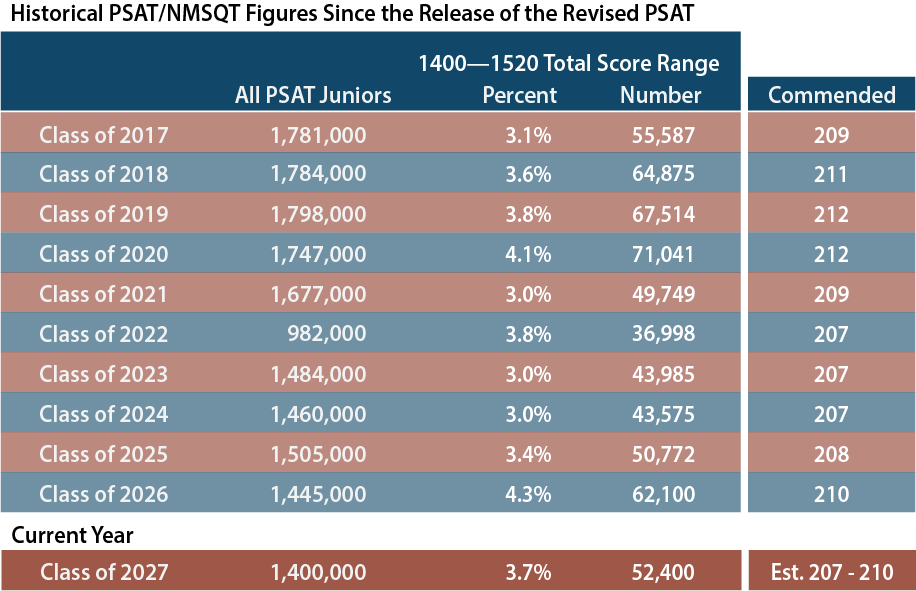
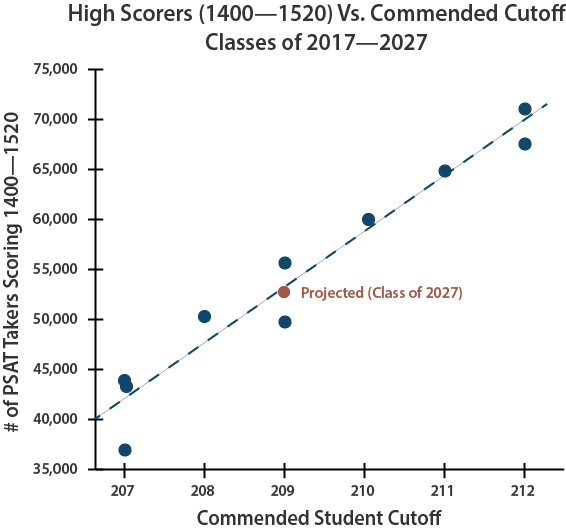


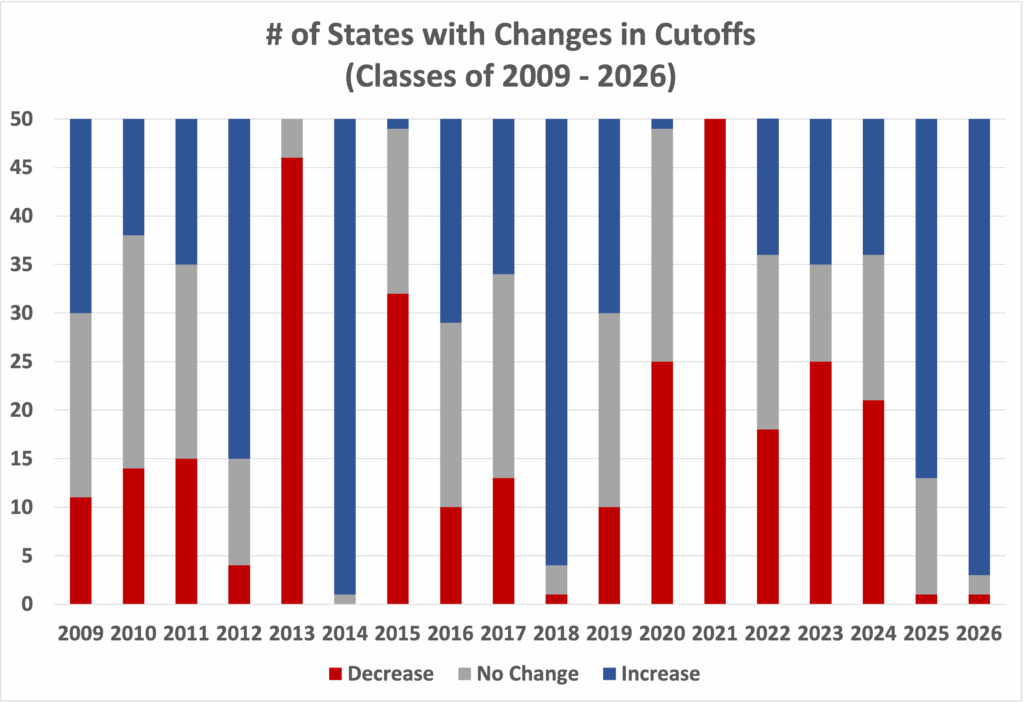
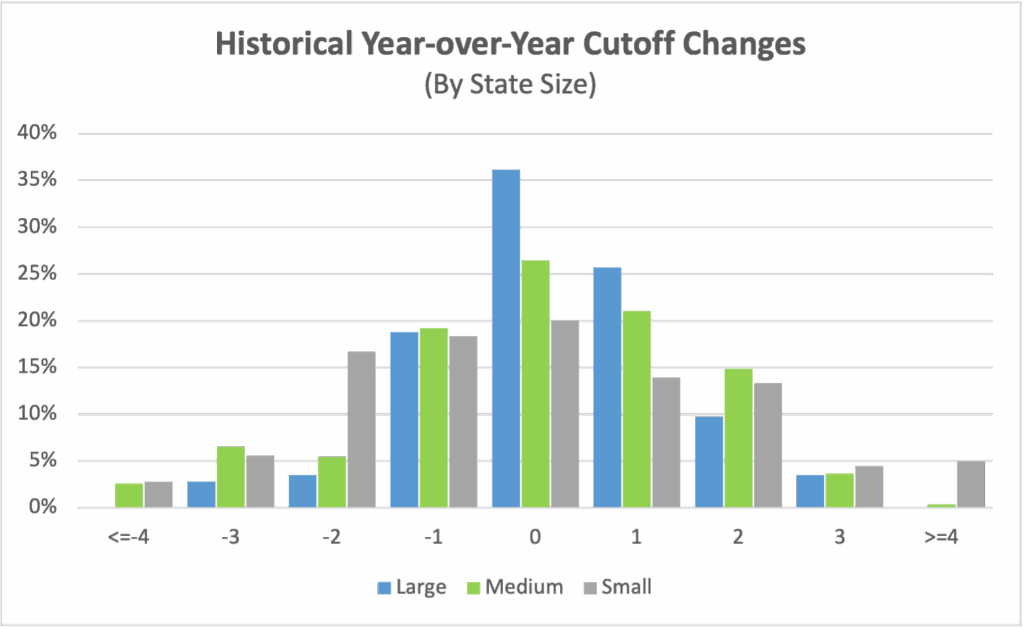
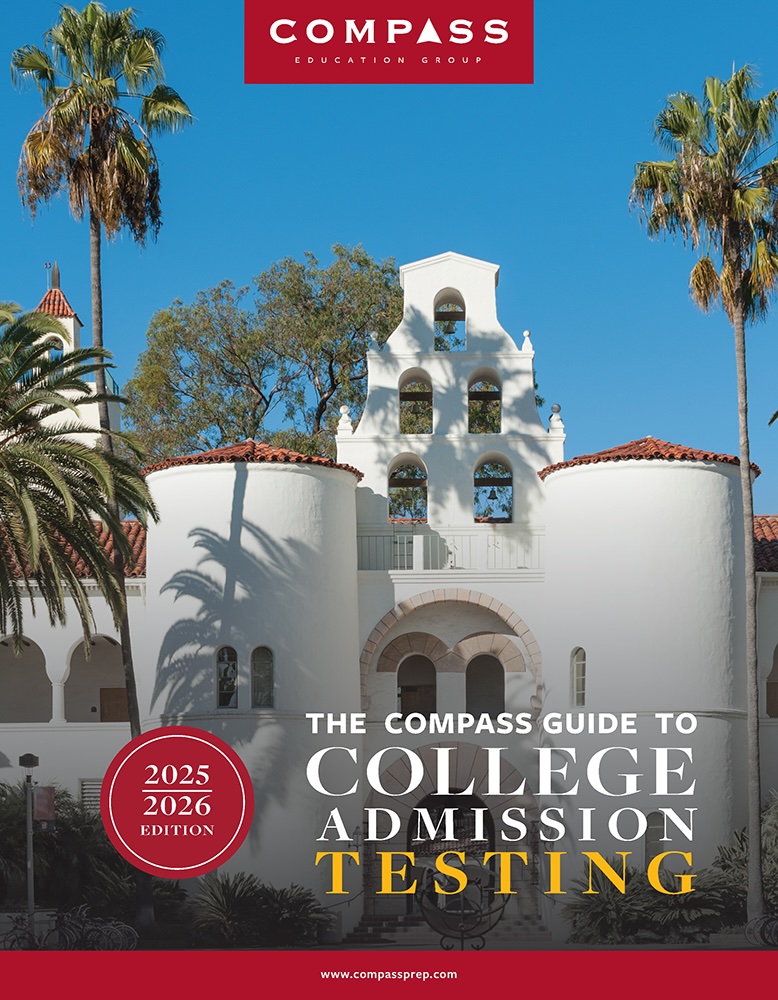
Hi Art. If my son has a 4.0 Unweighted and 4.8 Weighted with a 1480 SAT and 14 AP Classes (9 Completed, 5 Enrolled Currently), but he has repeated 2 classes (four repeated semesters) will he likely move on to finalist? Will the repeated classes hurt his chances? He is currently class rank 1. The grade he received before is not present on his transcript, but it shows that he retook the classes. The classes he repeated were both prior to high school (Algebra 1 and PE). He also has relatively strong extracurriculars (NHS Pres, team captain of both sci oly and sci bowl, lots of volunteering, plays piano). Thank you for any insight!!
Concerned,
I’m speculating, since NMSC does not release specifics on its criteria, but I can’t imagine that the repeated classes would disqualify him. If I am interpreting correctly and these were before high school, then they definitely will not play a role. And since the original grades aren’t on his transcript, it seems unlikely that NMSC would try to guess as to the reason he repeated the classes. Best of luck to your son!
My daughter still hasn’t gotten her official notice from her school and it’s really driving me bonkers. She asked her counselor yesterday and they just said they don’t have them yet. I find that so hard to believe when other schools are posting pics of their students pictures. I’m stalking everyone to get the Ohio list just so I can see her name in writing. I don’t know why, but I need to see it in writing.
When is the application due? I’m afraid she isn’t going to have enough time since she has no way to log in.
I don’t know if it’s any consolation, but this sort of thing is common every year. Sometimes it’s just the post office being the post office, and other times things go into a mail room/principal/counselor void for a few days. Your daughter can get started on the essay (on our FAQ page) and the rest of the application will take her less than an hour if she has already been gathering basics for college apps. If you haven’t had official confirmation, you can call NMSC. They can’t give you login credentials, but they can give you some peace of mind. The due date is October 9.
Thank you. You really are the best!!! I appreciate all of your help.
I found out from my friend that my son made it today (Georgia). Here’s the GA link from the AJC: https://www.ajc.com/news/local/students-fulton-county-move-toward-national-merit-scholarships/
Now what do we do? 😁
Congratulations, Alpha! You’ll need to get the letter from your son’s school with login credentials to the Finalist application portal. If your son once to get a jump on it, we’ve got the essay prompt on our FAQ. You have until October 9.
Complete New Mexico list:
https://www.abqjournal.com/1364695/nm-national-merit-scholarship-semifinalists-announced.html
Thank you, K. Adding it now.
Nebraska list:
https://www.omaha.com/news/education/primary-secondary/super-smart-nebraska-high-school-seniors-named-national-merit-semifinalists/article_1b11e7ed-a0d7-55b7-a4e1-6f7afa02a4a5.html
Thank you, Scott.
Idaho list that I found by googling. It would be great if someone can find the list for MA
https://www.blaineschools.org/cms/lib/ID01806336/Centricity/Domain/4/20%20ID%20Semifinalists-NatlMeritProgram.pdf
Thank you, SKT. I haven’t seen the MA list yet.
Fairfax County in Virginia has the list in : https://www.fcps.edu/news/two-hundred-forty-four-students-named-2020-national-merit-semifinalists
Thanks Art for your support , one year’s waiting period would be hard without you.
Thank you, Grace. I’ve got to start thinking about the class of 2021 in a few weeks.
Is there a complete list for Utah?
Bala,
I have not seen one yet. Many news outlets choose to focus on local students. Many state lists are never published in full.
For anyone who is still unsure of their status because their school didn’t get the information, just call NMSC! I got a 221 and I’m from Idaho so I knew I made the cutoff but my school said they hadn’t received anything. I called NMSC and they confirmed that I’m a semi finalist. They’re super nice and helpful, and the phone call was only a couple of minutes.
Great advice, Kristen!
My selection index is a 214 in Texas. But I’m still not on their list. Why is that?
Davis,
A 214 is not high enough to be a Semifinalist in Texas, but it is high enough to be a Commended Student. The list of Commended Students comes after the list of Semifinalists, so your school may not have heard yet.
Hoping you can clarify a few things for me. My daughter got a 225. SAT confirming score is 223. Is this a problem that it is lower? Should she take the SAT again? Also, she’s already been accepted academically (she’s a dance double major so still needs to audition) to a school that offers scholarships. Any insight on that process? It looks like they don’t notify you of school-sponsored scholarships until after the May 1 acceptance day but finances will be a huge consideration in choosing a school.
Kori,
No, the 223 is not a problem. The confirming score level is a national bar and unrelated to a student’s PSAT qualifying score.
The best advice I can give is to contact the college directly. Those that offer scholarships do it because they want Finalists to attend, so they’re usually happy to help. In some cases, there are limits as to how many scholarships are given. It sounds like your daughter has a big head start.
The first step is becoming a Finalist. She will be notified in February if she qualifies. You are correct that NMSC doesn’t announce college-sponsored scholarships until May, but that doesn’t mean the college can’t tell you its policy in advance.
Here’s the MN list –
http://www.startribune.com/the-list-minnesota-national-merit-semifinalists-2020/560254131/
Thanks for the tip, Pete. I’ve updated the page.
How do I know if I was a commended scholar or not? I had a selection index of 219 and am in California.
Ronnie,
Schools were mailed Commended notifications last week, so you should be hearing soon. The cutoff is 212 nationally, so you definitely made it.
Is 212 good enough for commended in Missouri?
Yes. 212 qualifies for Commended across the country. Congratulations!
thanks, will my school tell me?
Yes, they should.
Has anyone reported seeing an Ohio list? My daughter still hasn’t heard from her school. I’m not a very patient person. It’s driving me insane.
Sorry, Dana. I’m not counting on an Ohio list to surface at this point. I know that you’ve been wanting to see something in writing. You did call NMSC to hear it from them officially, correct? (847) 866-5100
Thanks, Mr. Sawyer. She got her login from her school today. I can slowly regain my sanity now. 🙂
Here is the MD list.
https://www.documentcloud.org/documents/6412419-Maryland-National-Merit-Semifinalists
Thank you for finding and sharing, Ann!
No problem! Thank you for this site. Very informative. It helped me keep my sanity through the process 😊
Anyone has a link for North Carolina list?
Did you find the NC list? Could you please share?
Why is the notification process so broken?
My daughter scored a 224 so we knew she would make any cut off for any state….we are in Georgia and the only notification that we saw was because the Atlanta Journal posted kids’ names.
Nothing official has come from her school, just really curious why National Merit does not have a better method or at least encourages the schools to be more proactive with their communication.
Johnathan,
NMSC simply has not changed with the times. Consider yourself fortunate to have seen your name in the Atlanta Journal. There are plenty of students who have not seen their names anywhere and are still awaiting school notification. Even if we accept that NMSC wants pre-press release notifications to come from the school, why not publish all names after the press release? NMSC will tell students who ask, so it can’t be because they want to keep the information secret. Since news outlets are allowed to publish full lists, it can’t be for privacy concerns. I understand why NMSC doesn’t like to publish cutoffs, but they could easily post the PDF’s of each state.
Fulminating aside, congratulations!
Hi Mr. Sawyer,
Thank you for this information – I love Compass Ed and all your resources.
I’m not sure I understand the cutoffs. I live in NY. It seems to me that it’s not possible to get a 221 – our state cutoff. Is there something I don’t understand about the scoring?
If you get 38 (perfect) + 38 (perfect) + 38 (perfect) = score of 114 x 2 = 228.
If you miss just one that’s 38+38+36 = score of 112 x 2 = 224
If you miss two that’s 38+36+36 = score of 110 x 2 = 220.
Thanks for any help. This is such a crazy game!
There are a number of ways of getting 221, especially if we are only talking about the most popular date on October 10, 2018. You can find the conversion tables here.
Your example shows missing 1 as dropping a student to 36. That’s not always the case. Sometimes it doesn’t drop a score at all. Sometimes it can drop a score 0.5 points (Math scores are not necessarily integers), and sometimes it can drop a score below 36, as it did on the Math section on the October 24 exam
On the October 10 test, a student could have missed 2 Reading questions and still been at 37; 2 Writing & Language questions and been at 37; and then still been able to miss 3 Math questions and get a 36.5. This would have produced exactly a 221.
On the October 24 test (a much easier exam), the scale was far harsher. You are correct that a student could not have earned exactly a 221. A student getting 2 Reading wrong would have received a 222 (35 / 38 / 38). Same thing for 2 wrong in Writing (38 / 35/ 38). Any other combination of 2 errors dropped a student below 221. It’s why I’ve often complained about that test form.
Many thanks!
Here is the Illinois list. I don’t think I saw an exhaustive list submitted already.
Thanks for all your work Art!!
https://adc.d211.org/cms/lib/IL49000007/Centricity/Domain/48/2020-IL-Semifinalists-Natl-Merit.pdf
Thank you, JC. That’s the first I’ve seen it.
Someone posted the WA state list on College Confidential this morning.
https://www.seattletimes.com/seattle-news/education/washington-students-named-national-merit-scholarship-semifinalists-seattles-lakeside-once-again-tops-list/
Thanks for passing this along, Heidi. I’ve added Washington.
I need a commended list from last April, how do I find this?
Nikol,
There is no Commended list from April. Principals are sent a list of students who NMSC believes will be eligible, but the determinations are technically not final. In September (last week, in fact), schools were sent final lists. I have never seen a complete list published. Some schools will recognize their own students. Students are only notified via their schools.
When would the current batch of semifinalist packets be received by the high schools? I guess the results have been public since September 11 so I’m surprised that our high school here in New Mexico hasn’t reported receiving the packet (my son is the only one at his school; his name was in the Albuquerque paper so they know).
Here’s a link to the Albuquerque Journal article giving statewide results: https://www.abqjournal.com/1364695/nm-national-merit-scholarship-semifinalists-announced.html.
Sounds like lots of folks haven’t gotten their packets yet.
Thanks, Jim.
Jim,
Notifications were mailed August 27. The late notifications I hear about are usually
(1) USPS taking its time
(2) Mail going into a blackhole at the school (front office/principal/counselor)
(3) Counseling office being overwhelmed or unfamiliar with the process.
If it goes on much longer, I’d see if the school can reach out to NMSC. It’s great that you were able to see it in the paper!
The packets apparently are addressed in a generic way to the principal and our high school has a new principal so got mislaid. Maybe the envelope looks a bit to generic to command special attention?
Thanks for the info about dates and times; it was good to know it was time to panic!
Hi Art!
Thank you so much for tremendous amount of helpful information you provide regarding the NMSF. My daughter earned an index score of 213. I believe, according to the information you provided, that should earn her Commended status. However, her school has said they did not receive any notice from NMSF. I know Commended status does not hold the weight or provide the opportunity for scholarships like semifinalist but it is still important to her. Do you know if NMSF just has not released a list of Commended students yet? Any insight you could provide is greatly appreciated. Thanks, again, for all the info your provide!
Kristine,
The notice to her school may just be delayed in the mail. It comes separate from Semifinalist notifications. Her 213 would definitely qualify her. I’m glad that she takes pride in her achievement and hope that the notification comes through shortly (if it hasn’t already arrived).
Do you know when commended students will be officially notified by their schools?
Elizabeth,
It is up to the schools. I’ve even heard of schools that don’t bother to notify students. Schools should have now received word from NMSC. Any eligible student receiving a 212 or higher and not qualifying as a Semifinalist is named as a Commended Student.
Hi Art- Sorry to sort of ask you this twice- but I can’t find my old question and your response from the spring. My daughter qualified as a semifinalist. She also has a confirming SAT, excellent grades, and no discipline issues, etc. However, she has almost no activities. She did do a full time internship in physics at our local university for the last two summers. That’s basically it, besides a little bit (once a year for the past several years) of volunteering for a local non profit. She has a physical disability and taking care of her health has been a priority. Do you think she has a good chance of qualifying as a finalist even if they don’t know her status as a person with a disability (which partly explains the lack of activities)? Thx
HM,
Activities are not a factor in Finalist selection. Your daughter’s SAT scores, grades, and school recommendation are the qualifying factors. Activities are looked at when students are considered for NMSC-sponsored scholarships.
Thanks so much
Hi,
Can someone explain how they derive at this cut off because kids take the exam for 1520. How is that converted to this cut off? Of 1520 what score they need to get the cut off score of 219 for Florida.
Hi Thiru,
You cannot directly calculate a Selection Index from a total score (320–1520); you need to know the individual ERW and Math scores. But, once you have those numbers, the calculation is easy: First, ignore the final zero in your scores; then double your ERW score; then add your Math score. For example, a student with an ERW score of 690 and a Math score of 720 would have a Selection Index of (69)x2 + 72 = 210.
Thank you so much for explaining it Ms. Margaux.